The temple at ThanjavurEvening darshan
The following is an extract from the travel book A River of Life: Travels through Modern India.
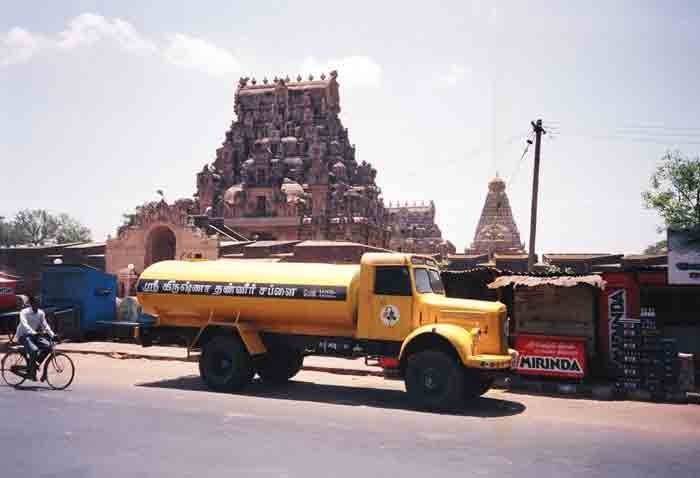
The main feature of Thanjavur, according to guidebooks and Department of Tourism leaflets, is the Brihadishwara Temple on the west side of the city. I head there in the middle of the afternoon.
I exercise caution on entering the compound: the temple is still active. But it is big - it is vast - it is colossal and, in consequence, impersonal. Temple interiors in India, North and South, tend to follow the same general pattern, which is to say they diminish towards the centre. Towering gopurams at the entrance lead to smaller and smaller entrances and towers until the temple's sacred heart is reached. It is a way of ensuring the polluting gaze of non-believers don't intrude beyond the periphery. But such an idea is a relatively late one in the history of temple design. Certainly those of Orissa (such as the Lingaraj Mandir), with their tall beehive sikharas that are visible from outside even without the aid of viewing platforms, don't conform to any such precept of design. Nor does the Brihadishwara of Thanjavur. The tower of its main shrine juts far above the line of its outer walls, dominating the city skyline, visible from far beyond the corrugated-iron roofs of soft drink and souvenir stalls that line the approach to the temple.
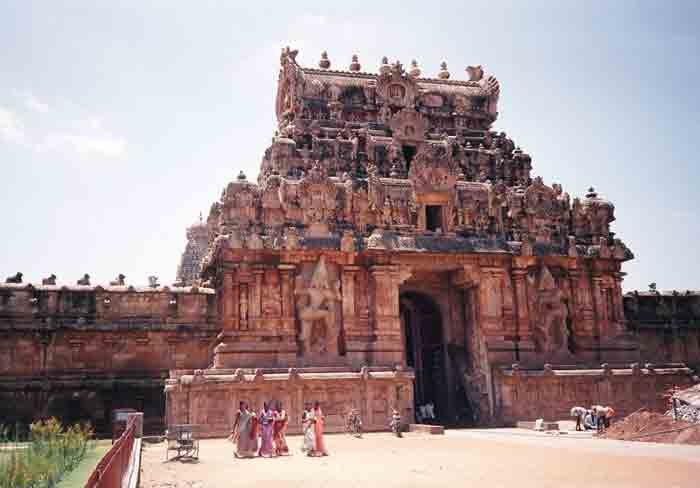
Fanged demons greet visitors to the Brihadishwara Temple with wicked stares, a warning to the unwary. The chappal minders in a kiosk just inside, charging 25 paise for each pair of shoes, are doing a good trade, although many of the people who are there are there for the same reason I am, not to worship but to admire, to be overawed. And the temple interior is, there is no denying, an overawing sight. The big empty spaces around the main tower, by the satellite shrines, in the colonnaded hall surrounding the courtyard, serve to diminish the scale of activity within. The temple, built during Chola times and the reign of its patron, Rajaraja I, is meant for larger gatherings than this, a greater scale of devotion, and I find it tough to imagine the hundreds of temple staff who had been employed here during its heyday: the tailors and porters, dhobi wallahs, goldsmiths and carpenters, the troupe of musicians, accountants, attendants, astrologers. In the grace of a Tamil woman, the elegance of her form and face, a jaunty lightness of foot, I can see one of the many hundreds of devadasis - female dancers, "slaves of god" - who were bound to the temple in those bygone days.
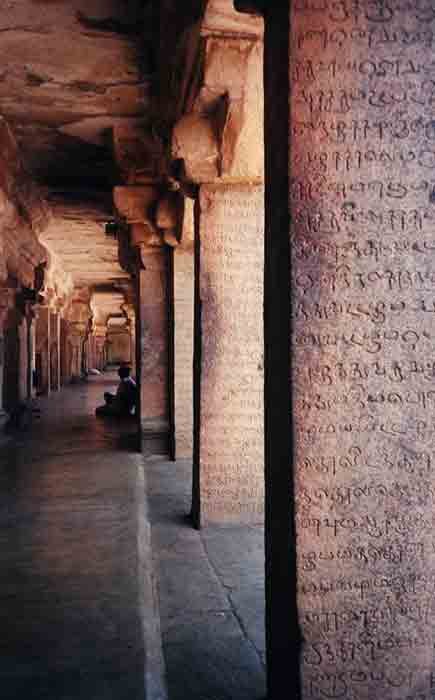
There are faded black-and-white prints in the small archaeological museum in the far comer of the courtyard, showing how the temple had been until relatively recently, the turn of the century, wild and overgrown. I decide, all in all, I prefer it that way. The well-trimmed strip of turf at the columned fringe of the courtyard and the tamarind trees, throwing neat umbrellas of shade onto the grass, seem very twee to me. This isn't the way relics of the past are supposed to be, certainly not one-thousand-year-old ones such as the Brihadishwara Temple. It lacks the romance of disrepair, the tumbledown splendour that can speak so eloquently of faded glory. Even the sculpture has weathered well. In welcome contrast to those fanged demons, set at the entrance, are the seductive maidens adorning the colossal tower of the main shrine in the heart of the courtyard, their allure, like the demons' menace, remaining little diminished from the day they were first hewn from blocks of sandstone. Thanjavur had been the capital city of the Chola empire from the 9th to the 11th centuries, and if nothing else the grandeur of the temple and its sheer excess, breathtaking even in the present day, is an indisputable advertisement for the power and dominion the Chola kings had once held in this region of India. Their sea power had even allowed them to bring Sri Lanka and parts of Southeast Asia under their control, and indeed it was the Chola-mandala, land of the Cholas, which later gave its name to the whole east coast of India: the Coromandel Coast.
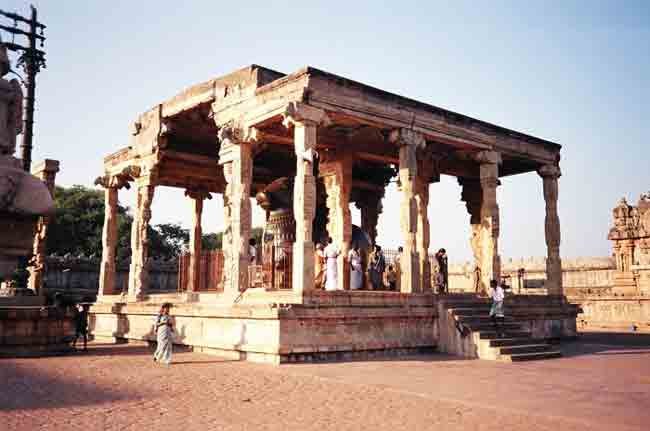
The temple interior is steeped in stillness, an intoxicating atmosphere, dulling nerves made raw by the madness of the city streets outside and obliterating, by dint of its size, the cacophony of noise from traffic that is far, far away. I sit on the well-trimmed lawn and watch the world go by. Indian tourists with cheap cameras strike poses at the base of the main tower, a structure some 200 feet high. Devotees perform puja at the various shrines around the tower; others pour oil over the big black statue of a Nandi bull.
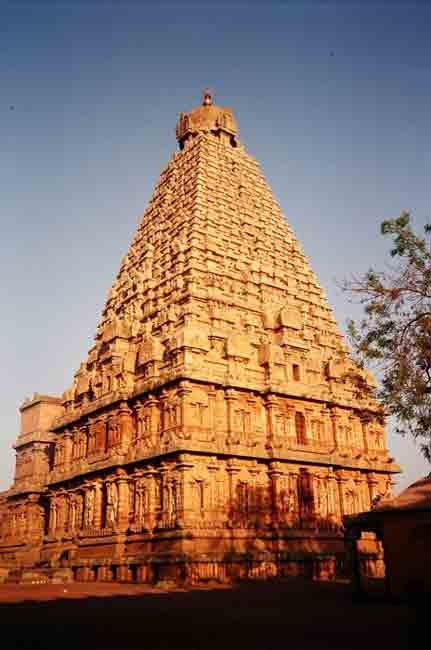
As the sun sinks and begins to set a succession of tentative melodies sound from the entrance to the main shrine within the tower, played on a nagaswaram, an oboe-like instrument. People begin gather, summoned by the music. It is time for evening darshan, when the curtain is drawn back from the sacred Shiva lingam inside the sanctum sanctorum. To an accompaniment of tavil drums, the nagaswaram plays on. It has a mellow sonorousness, like a saxophone soloing in a jazz ensemble, except that the melody is slower, more stately, with jerky embellishments that give it a distinctly Indian tang.
Just as dusk is tilting towards full darkness, the musicians come away from the temple entrance to lead a procession around the tower. The silver statue of a Nandi bull, vehicle of Shiva, is borne along behind the musicians on a wooden pallet, draped in garlands of white marigolds. The assembled people, perhaps two or three dozen of them, walk in a ragged band behind, while at the very front is the smaller of the two temple elephants, tricked out in paint and gold beads, plodding along to the wailing accompaniment of the nagaswaram and the tavils' erratic tattoo. The procession disappears awhile behind the tower, re-emerges, halts in front of one of the smaller shrines. The crowd thickens. The crowd thins and dissolves. The elephant is led back to its cramped stable at the entrance by the chappal stall.
I stay awhile longer, enjoying the quietude, then collect my sandals from the chappal stall and brave the chaos of the city once again.
Temples etc.
A River of Life
Read on...
Read the next article about the Sri Meenakshi Temple at Madurai.
The Sri Meenakshi Temple on Chitrai Street is the commercial and devotional focus of the city of Madurai, lying at the heart of its lotus plan. Being in the Southern or "Dravidian" style, the most arresting feature about it is, naturally enough, the soaring gopurams over its cardinal entrances: brash and impressive, beautifully colourful, covered all over with sculpture.
Go back...
Read the previous article about Arjuna's penance.
Popularly known as Arjuna's Penance, the largest bas-relief in Mamallapuram is also the largest in the world, measuring some 90 feet long, some 30 feet high, carved onto the face of a boulder that had once formed part of a large cliff face. It has other names too, reflecting the fact that no one is quite sure what it depicts: Bhagiratha's Penance and Decent of the Ganges are other favourites.

Available for purchase now
Sheldon's account of his overland travels around India, A River of Life, is available for purchase now. Buy the e-book from Amazon.com or Amazon.co.uk, or the paperback from Amazon.com or Amazon.co.uk (also available in other countries, search Amazon for more information).
The first instalment, A River of Life, Book 1: Travels in the North, is available separately (e-book format only) via Amazon.co.uk or Amazon.com. The second instalment, A River of Life, Book 2: A Tour of the South, is available via Amazon.co.uk or Amazon.com.
